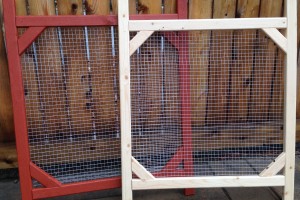If you’re interested in the compost screen, either buying or making one (instructions here), please see the pricing and FAQ below which I originally sent to a local gardening email list. If you live locally and would like to order one, send me (Jeremy) an email.
———————————————————————
These units are, by design, light enough that people without much upper body strength can use them. They’re large enough to sit across a wheelbarrow (width-wise) for easy sifting. They’re also light enough to hold in the air and shake back and forth without much strength.
To be so light, they’re not deep, meaning that one or two shovel-fulls of compost are all you can add at a time. Two shovels of compost can weigh a lot anyway, so for most people, the size is plenty big.
I’ve priced the units very low, covering material costs with a little bit extra for my time and to help cover my costs of the units I’m making for Arlington schools, helping local school gardens and similar associated costs.
I buy the materials in Arlington to support local businesses. The wood is all plain, untreated, pine or poplar. I recommend painting/staining, which I can do for you. You can choose either ½” or ¼” mesh screen – I like having both. I’ve had mine for about five years, leaving them outside in the rain for weeks at a time (not recommended) and they are still going strong.
Pricing:
Screen, unstained, with either ½” or ¼” mesh = $30
Screen, you take it home to paint it, bring it back and I’ll attach the mesh = $30
Screen, you give me your preferred paint/stain that I apply = $45
If you want a custom design (eg, longer, wider, etc.) then we can talk. If you make a lot of compost and want a hand-powered trommel, I can do that also.
FAQ
Q: Do I need a screen?
A: No.
Q: Is there something special about this screen compared to others?
A: No.
Q: I already have a sifter/screen, do I need this too?
A: Definitely not.
Q: So, uh, why should I buy one?
A: No need to, or if you want, you can probably make one yourself with the instructions here. If you want to get “chunky” stuff out of compost before spreading it in the garden, this makes it easy. Also, if you want finer compost for things like making your own potting soil or planting delicate seeds (eg, carrots), a screen is helpful.
Q: Can’t I just use a milk crate?
A: Yup, and that will do an excellent job getting the largest chunks out.
Q: What about the heavier, deeper ones made of 2x4s?
A: Those are great too, but they’re a bit heavy. This is light enough that anybody can use it, and because it is only 1” thick, it stores in the shed/garage against the wall without taking up much space.
Q: That looks so simple, can’t I just make one myself?
A: Absolutely! You can find detailed instructions, free, here, complete with dimensions, instructions and photos, anybody with a few basic hand tools can make it!
Q: So if you’ve put the instructions online, why can’t I just wait and make one myself?
A: You absolutely can, they’re very easy to build. Or you can see many other designs online right now.
Q: You’re doing a terrible job selling your own product, you know that, right?
A: Thank you for noticing! The truth is that most people really don’t need a screen, and if you do need/want one, you can make it very easily. But if you don’t have the tools, time, confidence, or inclination, then let me know and I’ll do it for you for a modest fee, and everybody is happy.


Jeremy, I like your style! Thank you for demystifying the compost process and for increasing community awareness of how easy and low-tech it can be. As a community recycling coordinator, I am reminded at professional gatherings and through waste publications that food waste accounts for at least 20% of our curbside solid waste, by weight. The more of this organic material we can turn back into soil nutrition, the more money and fossil fuel we can conserve as a community.